Audrey's childhood in Kerikeri
(Chap. 2)
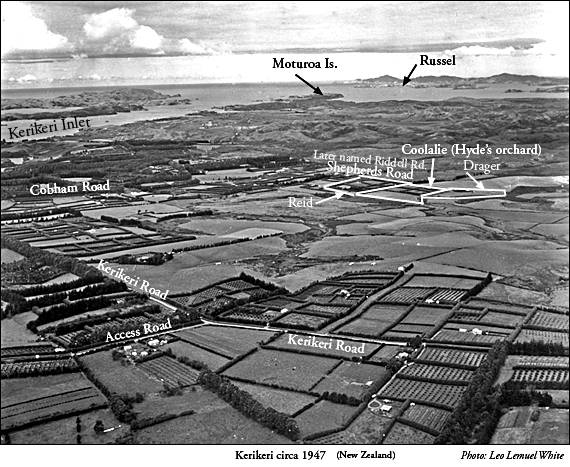
Audrey's childhood in Kerikeri
|
|
JOAN HYDE'S ELDEST DAUGHTER, AUDREY,
STORY OF HER CHILDHOOD IN KERIKERI
Chap. 1: Early Day's in Kerikeri Chap. 3: Dad's Army Chap. 4: Early School Days Chap. 5: N.Z. Friends School Chap: 6: Rivervale School and Pony Club Chap. 7: Marist Convent Chap. 8: Northland College Appendix I: David on "Life in Kerikeri" Appendix 2 - Coolalee's sale tender document Index for this page:
In 1936 they bought 13 acres of gorse in Shepherds Road, for 700 pounds. Shepherds Road is now called Riddell Road. The gorse was well over 10 feet high but Dad, with Mum’s help, slashed and burned the gorse and cleared the property in readiness for planting and the building of a small cottage. Approximately one third of the property was grassed up for paddocks, to keep a couple of house cows, and an acre was put aside for a house and garden, the rest of the land went into planting fruit trees. In 1935 they bought about 100 orange trees and planted them only to find out two years later that they were sold the wrong strain of oranges for the climate, so the whole lot had to be pulled out and Navel oranges replaced them. Fortunately they thrived. Losing that first planting must have been terribly disheartening, but being the strong minded people they were, helped them to overcome this disappointment and anyway, they had committed themselves by this time because we twins, David and I, had made our appearance into this world. 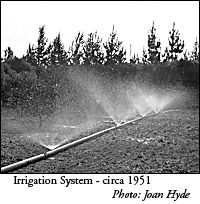
A further 100 Weenie grapefruit and 100 New Zealand grapefruit, sometimes called Poor man’s orange, were planted in another block and the final block had 50 Meyer lemons and Mandarins and at one end of this block, grew a Victory plum tree; Damson plum tree, and fig and quince trees. Each plot was separated by large Australian hakea hedges that had to be pruned back every two or three years and the pruned wood kept the old stove running. Dad also planted long rows of giant Chinese bamboo, between the grapefruit and orange orchards, and as far as I know, they are still there. Occasionally he would chop some of this bamboo down and save it for Guy Fawke’s Day. You had to keep well away from the roaring fire because the bamboo would explode, when hot, and go with a bang like a giant cracker. It was marvellous. 2. Building the HouseOnce it was realised we twins were on the way it was imperative to build a house so with the help of a neighbour, a carpenter called Lou Drager, Dad proceeded to build our house. It consisted of three rooms with a large partly enclosed veranda where we children slept. Only a large green tarpaulin kept the weather away from us, on one side, but it was cosy enough. The outside walls were made of fibrolite sheets and the inside walls were tongue and groove timber, later to be replaced with ‘Pinex’. The three rooms consisted of Dad and Mum’s bedroom, a kitchen and a sitting room. You had to walk outside to the pit- toilet which was housed in a shed and baths were taken in a large galvanized tub, about once a week, with hot water that was boiled up in a kerosene tin on the wood stove. We had no power until it was put into all the houses, down our road, in 1948; an event I will never forget because we children delighted in switching the lights on and off. No more lighting the kerosene lights or candles for us! 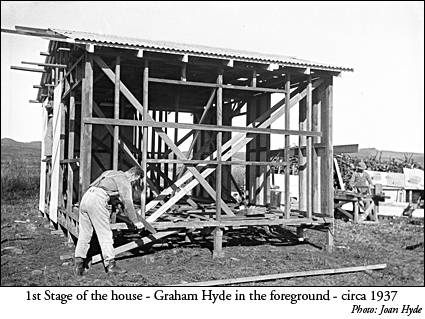
Dad planned the house to be centred on an acre of garden and in later years, the garden was very beautiful with wattles, cedars etc and large lawns and flower gardens, but the section I particularly loved, were the long line of flowering cherry trees planted behind the house. In the spring they would be smothered in every shade of pink and white and below them, masses of snowdrops and daffodils grew in drifts through the lawn. In the autumn, the cherry tree leaves would turn into brilliant shades of orange; reds and yellows, and beneath Dad planted autumn crocuses which had flowers of all shades of blue. Two months before we were born Mum had to go into the Whangarei Hospital to await the arrival of ‘the twins’. 3. Birth of the Twins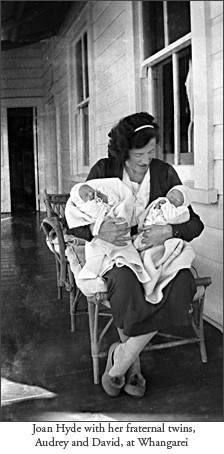
There was a hospital in Kawa Kawa, 20 miles away, but they didn’t have the facilities for such an event. While Mum was in the hospital, Dad made the final move from ‘Hell Hovel’ to the new house which he named ‘Coolalie” I think it is an aboriginal word for North wind. We were the first twins to be X-rayed, and born, in the Whangarei Hospital and I must say the only time I have come first in anything! Mum told me she was so huge, with us two, that she felt like buying a wheel barrow to prop up her tummy. We duly arrived on time weighing out at about 6lbs each. Dad bought an ex-taxi; a Ford 10, which we had right up until about 1958. It never missed a beat. Those were the days when a crank handle would do if the battery was low and ventilation was via the front window, that opened up at the bottom, if not enough air was coming through the side windows. The car was green so he nick-named it the ‘Green Beetle’. Mum had to stay in Whangarei for another month before the doctors would let her go home. Dad duly picked us all up in the ‘Green Beetle’ and home to Keri Keri we went. Twins were fairly rare around Keri Keri and Mum was assigned a nurse called Miss Toms who helped to look after us for the first few months, and then occasionally, until after Julia’s arrival approx. two years later. 4. Early days of the Twins, and Julia's arrivalMy earliest memory, at about a year old, is sitting in the double cane twin pram, with David beside me, and Miss Toms pushing us along the road. She was a large lady and wore a flowery frock and a sensible panama hat plonked on her head. I was wearing a cotton frock with pink flowers and David was wearing a shirt with blue flowers. Someone had sent the material, from England, for Mum to make our clothing on her trusty old hand-operated sewing machine. She made all our clothes on that machine and for the summers she’d bleach and embroider the old white flour bags for shirts for us and every year she bought, by mail order from the Farmers Trading Company, dungarees that we lived in. We hated them because we were the only children who seemed to wear them, but in later years they were the ‘in-thing’, and looking back I guess they were extremely practical for three little country bumpkins! 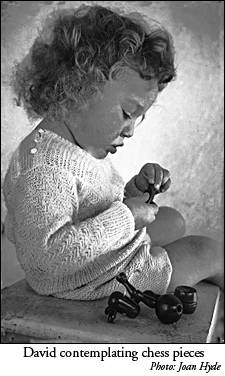
Although Mum was an academic, having gone to University, in Reading England, she was a very practical woman and was often far more practical than Dad. I have noticed over the years, that Academia and Practicality doesn’t always go hand in hand, whereas, Mum had it all and I think if she had stayed in England she would have done very well, however, there is no use dwelling over that! One episode Mum related to me, of which I cannot remember because we were only about eight months old, concerned a Lady?? who came to visit because she wanted to see the lovely garden Dad had planted. I believe she was rather a snob and on holiday from England. When she saw ‘the twins’, she gushed over us; picked David up and he gurgled and did all the right things. She then proceeded to pick me up and I screamed blue bloody murder and promptly wet down the front of her pretty dress! Mum tells me that, from that day on, she knew I would never tolerate snobs and how right she was! For Julia's birth once again Mum had to go to Whangarei to have her. She was a difficult baby because she refused to eat, so Mum certainly had her hands full with three children under two and the continual washing was a huge task; hauling all the washing down to the creek that ran through the back paddocks, but eventually a copper was bought and it was placed outside near the rain-water tank. They relied on rain water completely so there was a great need for conservation and at odd times, particularly in the hot summers, Mum would still have to traipse down to the creek. 5. Pets and farm animalsDad worked all hours, in the orchard, and by this time, he had bought two house cows called Sally and Polly. Sally was a bad-tempered Friesian and Polly a docile Jersey. I do feel though that at first Sally was also docile but Dad had a knack of making beasts ‘one man animals’ so to speak. Dads philosophy was, in this world, animals come first; men second and women third in his estimation! 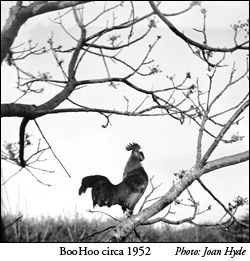
Later we were to have a horse, called Flo, who was bad tempered, and who can forget the Sealyham called Bill. Both Julia and I have scars from that sod of a dog!! Also there was bantam rooster called Mr Boohoo. He would hide under the bushes and as one walked past he’d attack your legs and draw blood but he never attacked Dad!!! At least the two cats, Rangi and Toto, were docile and I can never remember them scratching us at any time. Mum was more the cat lover than Dad. They were handsome cats; Rangi was a short haired black and Toto was a silver Persian and they both lived to a respectable age. 6. The closest neighbourNext door lived a Maori family called Maraea and Ken Reid. They had a son called David who was a couple of years older than us. Ken worked for Gordon Johnson (Stewarts’ brother) driving tractors. He went all over Keri Keri tilling the soil between orchard rows. Both Maraea and Kenny worked hard. She was always toiling away in their own orchard and occasionally she would come and baby-sit for Mum and Dad when they went out. We loved her looking after us because she spoiled us and used to bring a commodity with her that we were never allowed to have. White bread!!! She would bring butter and jam and we would make pigs of ourselves. Many times we would still be up and suddenly we would hear the Ford 10 coming along the road. We’d dive into bed and feign sleep and we never ever let on to what we had been up to. Years later Maraea and I would laugh about it and I asked her why she did it. She said she used to feel sorry for us because Dad would not let us have any ‘treats’. I must say though, in Dads defence, we were fed on what is now known as a very good wholesome diet. Mum was an excellent cook and could make lovely meals out of anything. None of us can possibly surpass her delicious puddings and the one hundred and one ways of turning the left over meat, from the Sunday roast, into something else for the next three days. 7. Horses and Joe JohnsonFew people in Keri Keri had cars before the war, but we all had horses and many farmers still used teams of draft-horses for their fields. The only other persons, aside from Gordon Johnson who owned a tractor, was Mr Driver who farmed behind our place and Alec Riddell who had very large tracts of land opposite. Most of the riding horses came from large herds of wild horses that used to roam on the land past Riverview, known as the Rangatata Block. There were a number of large tracts of land around Keri Keri that was not farmed and were known as Crown lands because they belonged to the government. These blocks were not put into cultivation until about the mid 50’s, I think. The large Karapiro block was the first to be brought into production, and our parents were very good friends of the first manager Mr Galilee and his wife. They eventually retired to Kaikohe. 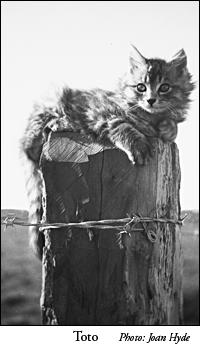
Joe Johnson, a real old character, was the one to be relied on to catch and break-in your horse. He also shod our horses and taught Julia and I, how to do it. One day we rode out with him to the Rangatata block and chased a herd of wild horses. I am positive Dad knew nothing about it!! The wild stallion was a beautiful Palomino and galloped with his brood of about ten mares and foals. We kept up with them, on our own horses, and it was an exhilarating experience which I will never forget. Jo wanted to see which one of the herd, to lasso and break-in. Later, he would sell the tamed horse for about five pounds! This price seems incredible now, but I would think that five pounds, then, could be worth $500 these days! The nearest pub to Keri Keri was the Ohaewai hotel. The Homestead was in Keri but it only had a house bar. About once a month Jo would ride over to Ohaewai; get blind drunk and someone would heave him up into the saddle; tie him onto his horse; he would then snore off and wake up outside the door of his home! No traffic to speak of in those days, and also no traffic police. The nearest police station, from us, was in Kaikohe and every Thursday Mr Ryan would come to Keri Keri, in his trusty old green car and check on local criminals. Dad always threatened us with Mr Ryan and we would be angels on Thursdays! One of Joe’s horses (I think it was called Gaylord or a name like that) did very well at the Waimate show with his owner, our friend, Billy Henderson. One day, Billy was out riding on this horse and he saw a ‘cast’ sheep in a paddock. He took his horse over the fence but the horse caught its hoof on some wire-netting, which was attached to the fence, and did a flip, I believe, and Billy died of his injuries. He was about the same age as us and as well as being at the same school, he also belonged to the local Pony Club, as we did. It was a great shock to everyone, in Keri Keri, because we were all very proud of his show-ring achievements and what’s more he was a very nice polite young lad and liked by everyone. 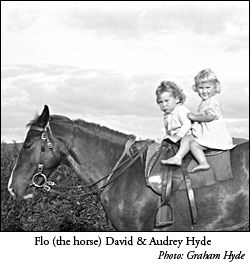
I think it made us realise how very vulnerable one can be when riding horses. Now, I shudder when I think of the way we used to hang sideways; nearly underneath, a galloping horse, trying to imitate some Cowboy and Indian film we had seen!! Standing on a galloping horse was another madcap thing. Years later, an elderly lady said to me that she was very surprised to see me reach my 21st birthday, because she was sure I would be killed on a horse. 8. A new hair style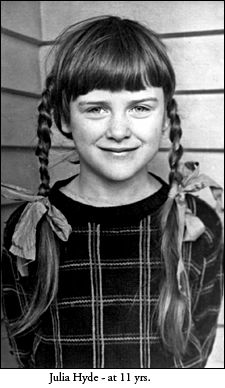
Our lives were fairly idyllic until war broke out and then the changes came into our family life, but before finishing this chapter I must relate one naughty thing we twins did. Dad always lamented that he had no child with red hair like his. His hair was a deep chestnut colour; I was a flaxen blonde; David had dark hair and Julia had blonde curls, but wanted to oblige Dad. David thought he could help. On one of his rambles he had spotted some red paint on Maraea’s and Ken’s property so he helped himself and got a couple of paint brushes from our shed. He conned me into helping him to paint Julia’s hair. She was delighted, but needless to say, it did not delight our parents and it took weeks before Mum managed to get all the paint out, and after that episode, her hair went thick and straight and mousy brown in colour. |
|
|
|
|
|